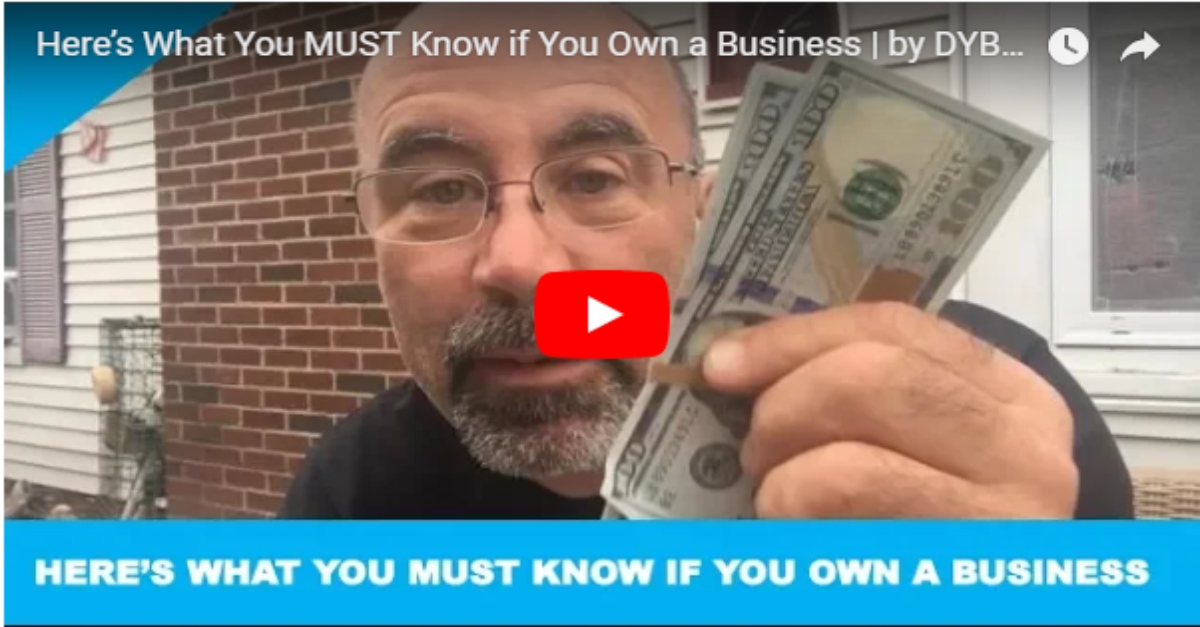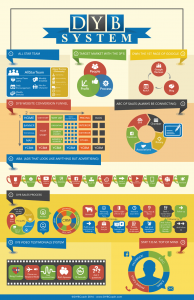
Here’s What You Must Know If You Own a Business
I am Ron Ramsden and I am a DYB coach, also a painting contractor…
Today, I want to talk ‘Money’ with you. Money is a hard subject, sometimes with spouses and families, and it is also hard for business owners, to come to the realization that it’s probably one of the most important things you have to talk about.
The basics
So, if you are a bigger company, you have been around for a while, then this video is probably not for you.
But there’s a lot of people starting out who haven’t been educated in money, profit, losses, gross, net, why you should
have a separate checking account and such…
I want to talk about the very basics with you, of running the business with money and some of the terms and things you should be thinking about.
We all hear about these companies that are doing a million dollars, $800,000, $500,000… if you are a smaller company, that’s a little overwhelming when you are doing $150,000 to $300,000 and you can almost wonder, what if?
When I get there… But it doesn’t really matter how much money you have, it’s how much money you keep.
There are many companies out there doing $800,000 to a million dollars who are broke, don’t be broke, you can do very well with $200,000, $300,000, $400,000.
Gross Income
Anyways, we will talk about Gross –this is when you hear a company that adds up all the income they receive throughout the year, maybe they did some power washing, maybe some exterior painting, interior painting, things like that.
So, all the money they have received across the entire year is called Gross.
That is their Gross, so you hear a lot of companies say, “I have made between $350,000 and $400,000”, “I make between $800,000 and $900,000”, “I just got to the million-dollar mark”.
That’s in Gross money…
Net income
Now, if you take up all the expenses we have, it’s similar to your own personal, but we are going to keep personal out of this.
So, when you are operating a business and you sell a job for $1,000, you might have $150 worth of it –it might be supplies, the paints, the wallpapers, sanding, blocks, all that other stuff, that’s they supply, that’s an expense.
You have labor, you might employ 1 or 2 people for a day –that is an expense.
You have insurances, those are expenses.
So you take out what it cost you to actually perform the job, (the money paid out – including the supplies and all the other expenses) and minus what they pay you –that will be your Net.
Note: The Gross is the thousand and the Net is what actually you keep after all payroll, all taxes, all supplies, and they add up to a lot.
In the average painting world, we hear about Net profit average, and we don’t like average.
We’re going to go with averages, like into 11%, and sometimes 12%, we find a lot of painters doing 15% and close to 20%, and there’s a few that are a little higher than that – they have been around, they have really kept their expenses under control and they are also working very efficiently with their teams.
So, we want to look at it, if you are running an average, we are going to run 11% as Net, and you did $100,000 this year.
So, after everything was said and done, including your own salary, all the bills are paid, you hopefully have $11,000 leftover, after everything that is said and done, so that’s 11% Net, and if you do $200,000, that’s $22,000, so keep adding 11%.
11% of $100,000 is $11,000. And say you did $400,000, you have $44,000.
Can you imagine if you controlled your expenses, similar to purchasing your supplies at Scott shared in one of the other videos, the price you shop around, you control your wasted time, you are careful of what you spend your money on, your insurances, your vehicles and things like that.
You don’t always need bright, new, shiny vehicles, used vehicles work very well.
And then, if you can control it, your net profit will slowly creep up, as you have been around and you increase your
bid rates, you are going to find your Net Profit, if you can control the expenses, will slowly edge up.
So, if you are doing $400,000 a year and have a net of 11%, you make $44,000, so you have already taken your salary, at the end of the year you have profited $44,000, I am not talking about what you owe Uncle Sam on your profit, but you have $44,000.
If you could edge that up from 11% to 13% so that $44,000 now becomes $52,000…
As you get even higher, you can get a 15% net, now you are not only taking care of your own salary, all the expenses for the company, for the year, you have an additional $60,000. So, that’s the difference between Gross and Net.
Checking accounts
This is another one… and they actually didn’t have a separate checking account for business.
I know if you have been around for a while, you know you should have this.
When you are starting out, it is sometimes hard because there is not enough money to have 2 checking accounts, but it is very important to have 2 checking accounts –it’s too easy to spend each other’s money.
Personally, you see something, there is money in the bank, you use it, for the business, you want to make sure you
have 2 checking accounts; you have a business account through your bank as well as whatever you do for personal.
‘Drip Account’
And then, once you get established, very important… We call it a ‘Drip Account’, what is a drip account?
This is a saving account from a bank that you can automatically transfer money without even touching it.
You set up a weekly transfer from your business checking account into a business savings account, and it is very easy when you are starting off, you start it out with $10, for a super small company.
It doesn’t sound like a lot, but that is your rainy day account.
When things get better, you increase that, you might increase it to $20, $25 a week, $100 a week, $500 a month, and then before you know it, that account is there if you need it… you know that emergency when a truck breaks down and there is no money?
You have your emergency account, that’s a business savings account, it is good for emergencies, it is also good for maybe a bonus, maybe a set shop you look down the road, or maybe it was a new truck.
I took a huge chunk last year out of my savings account to put down a brand new truck, it is for emergencies at the beginning, and then actually it can be part of savings.
And some of us have multiple drip accounts which we use for taxes because we pay quarterly taxes, so we automatically take that out weekly, and also our business savings account.
Those are the basics you will need. Also, a book that I have to recommend that has helped me out greatly, especially if you struggle with your finances.
I generally don’t recommend books on any of my videos, in fact, this is the first time I ever have.
If you have a struggle with making a budget, and what I mean by making a budget is that… list all your expenses, personally, and then you have a business budget.
So you have your own personal budget that you know where every dollar is going, every week, but also a business budget, you know you risked your gas for the month, you risked your truck payment if you have one, maybe a little repair budget in there also.
You have a cellphone budget, we have our insurances, and you might have a payroll processing fee, which is part of the budget.
Payroll; you can take an average because it doesn’t matter how many hours you work, how many people are working, etcetera… But if you can actually run on a budget, you can actually have every dollar accounted for.
You can also have those drip accounts set up, you know we like to make profits, so always watch the bottom line, and if you do not watch the budget, you do not watch your bank account, you do not watch your cash flow, it is going to get away from you.
So, easy if you are using something like QuickBooks to help you with the finances. You can also use Fresh Books, those are very easy to use, if not do a paper budget, it will help you in the long run.
The book I recommend here is Dave Ramsey’s; ‘The Total Money Makeover’. If you are new to finances, you are struggling with finances, this is a great book.
If I can help in any way, answer some of your questions, I am not an accountant, I have made enough mistakes with money over the years, I’d love to chat with you.
My name is Ron Ramsden and I am a DYB coach, also a painting contractor.
This helped me with the basics and I want to keep you on a positive, profitable road as you work through your business. Have a great day…


